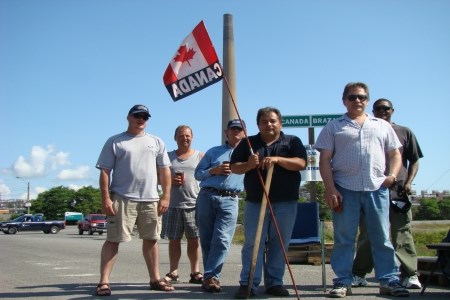The lasting legacy of the year-long strike of nearly 3,000 members of the United Steelworkers Local 6500 at Vale’s Sudbury operations will not be its economic implications, but its message about foreign acquisitions, said a local economist.
In fact, the standoff between the world’s second-largest mining company and workers in one of the globe’s most significant mining camps is now a reference point for all future takeovers, said Laurentian University professor Jean-Charles Cachon.
“The impact of it will be lingering for a long time, because I cannot escape making the parallel with what BHP Billiton (was) trying to do with Potash (Corporation),” said Cachon. “Now any corporation coming to Canada from the outside will not be very credible if they tell us, ‘Don’t worry, we’ll let you be as you are, you’re pretty good,’ and so on. Well, sorry, but now we’ve had a lesson there in Sudbury. So beyond the strike itself, there’s a much larger picture.”
Many of the opponents of the BHP Billiton-Potash deal used the Sudbury labour conflict as an example of the so-called dangers of such transactions.
The strike, which began July 13, 2009 and came to a close almost exactly one year later, saw some 3,100 workers on the picket lines over proposed changes to new workers’ pension plans. The new contract raised the price point for the activation of the famed nickel bonus, and capped it at a quarter of workers’ wages.
The year was one of bitter strife, with both sides taking the other to court on a variety of accusations.
The strike represented the loss of some $300 million in salaries in the city’s pool of $5 billion, which is nothing to sneeze at despite making up a smaller portion of Sudbury’s economy than in years past, said Cachon. “It had a significant impact, there is no doubt.”
There are other prominent examples of the somewhat muted economic impact the strike had on the community. Sudbury Area Mining Supply and Service Association executive director Dick DeStefano said that although there were challenges, none of his members declared bankruptcy through the labour disruption.
This is a testament to the wealth of experienced entrepreneurs operating in the city, he said, most of whom have seen such disruptions before and know how best to handle the issue, using part-time layoffs and reduced workweeks wherever possible.
He estimates that across the North, roughly 3,500 layoffs were seen as a result of the strike, almost all of which have since been recalled following the ongoing rise in commodity prices.
As with every hurdle faced by longstanding companies, the strike also offered up some important lessons for companies, who use the downturn to re-examine their export strategies alongside lean management techniques and product improvement.
“There’s been an attitude shift through the strike,” said DeStefano. “Some of the guys saw they needed to stop being reactive and instead be more proactive with regards to this stuff, which is good, because that’s something I’ve been pushing for the last eight years.”
The economic impact on suppliers was further mitigated by the fact that, through contractual obligations, the company still spent some $60 million on goods and services in Sudbury from September 2009 and August of this year.
Vale’s local spending on goods and services typically reaches $60 million per month, the vast majority of which is spent in the North, said John Pollesel, Vale Canada’s COO, speaking at a Greater Sudbury Chamber of Commerce event in mid-October.
Vale brass are moving forward, pointing to the fact that the end of the strike is providing the company with the necessary certainty for pressing on with major capital expenditures.
This new spending will total roughly $2.5 billion, and will include improving recoveries at the Clarabelle Mill, developing new deposits around the Sudbury Basin, as well as implementing its Atmospheric Emissions Reduction project.
“I firmly believe the five-year settlement we’ve achieved stands as a turning point in building a successful and sustainable future here in Sudbury,” said Pollesel.
While the future is positive for the company, local union figures say the strike will represent a dark spot on the city’s labour history.
Former Steelworker president Ron MacDonald said he dealt with a more open-minded company when he was in office from 1981 to 1987.
“At that time, the company was willing to sit down at the table and examine issues rather than say this is our position and that is it,” he said. “We were able to resolve a whole lot of issues.”
An example was the inevitable 10-month shutdown in 1982, which occurred during recessionary times. The company and union agreed to end a one-month strike so the workers could collect unemployment benefits, instead of $30 to $40 weekly strike pay. As well, the company would pay worker benefits, which cost them millions of dollars.
Unfortunately, gains made in the '80s simply do not apply now, he argues. MacDonald sees Vale as arrogant and uncommunicative.
“I’m very disappointed in their attitude,” he said. “I think their bottom line is money and there is no concern for the human element.”




